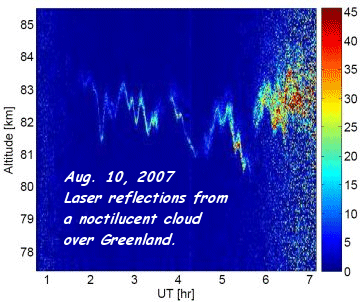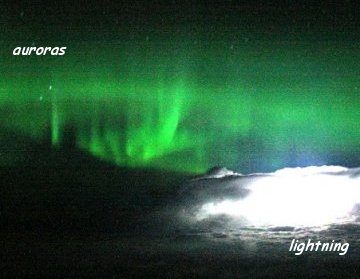 Where's Saturn? Is that a UFO--or the ISS? What's the name of that star? Get the answers from mySKY--a fun new astronomy helper from Meade. Where's Saturn? Is that a UFO--or the ISS? What's the name of that star? Get the answers from mySKY--a fun new astronomy helper from Meade. RE-ENTRY ALERT: A Delta 2 rocket body used to laucnh the COSMOS 1 satellite in June 2007 should re-enter Earth's atmosphere within the next couple of hours. Ground tracks shown here trace the possible reentry corridors; uncertainties in the rocket's decay rate make it impossible to say precisely where the fireball will appear. Sightings, if any, will be reported on spaceweather.com. SOLAR PROMINENCE: "There's a beautiful prominence on the sun today," reports Guenter Kleinschuster who took this picture from his backyard in Feldbach, Austria. The arcing cloud of hot hydrogen towers almost three Earth diameters over the sun's northeastern limb. Readers, if you have a solar telescope, take a look! more images: from Jack Newton of Osoyoos, British Columbia; from Cai-Uso Wohler of Bispingen, Germany; from Pavol Rapavy of Rimavska Sobota, Slovakia; from David Storey of Dougla, Isle of Man, UK; NOCTILUCENT WAVES: On August 10th, scientists from SRI International at NSF's research facility in Sondrestrom, Greenland, shot a laser into a bank of noctilucent clouds (NLCs) passing overhead. "This is the best way to probe these mysterious clouds from the ground," says lidar team member Jeff Thayer of the University of Colorado. Their experiment revealed not only the clouds' height and thickness (80+ km high and ~1 km thick), but also some strange undulating waves: 
"We believe the waves are caused by atmospheric gravity waves, or buoyancy waves, generated in the lower atmosphere and propagating vertically to the edge of space where noctilucent clouds are located," explains Thayer. When the waves reach the upper limit of Earth's atmosphere, "they can become unstable and crash – much like waves approaching and crashing on a beach." "We have been 'pinging' NLCs from Greenland for more than 12 years, but every time it is exciting and novel," he says. During this particular observation, NASA's AIM satellite was flying overhead and observing the same waves from above. "The combined analysis will be extremely informative and exciting." 2007 Noctilucent Cloud Gallery
[Night-Sky Cameras] ["Noctilucent Cloud"--the song] AURORA WATCH: On August 11th, a solar wind stream brushed against Earth's magnetic field. It was a gentle impact, but enough to produce this fantastic display: 
Brian Whittaker took the picture from an airplane 35,000 feet above the USA-Canada border near the Lake of the Woods. "This great display of green auroras lasted several hours," he says. "It was particularly beautiful in the northern USA where dramatic thunderstorms actively illuminated the horizon at an alarming frequency only to be supplemented by the occasional Perseid." Another solar wind stream is due to arrive today or tomorrow. High-latitude sky watchers, be alert for auroras.
2007 Perseid Meteor Gallery
Updated Aug. 14, 2007 | 
